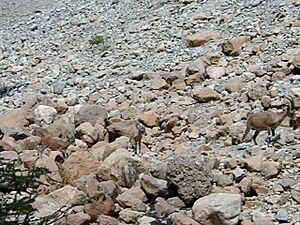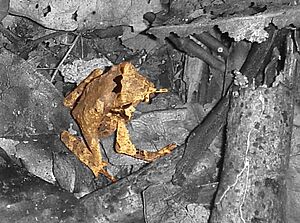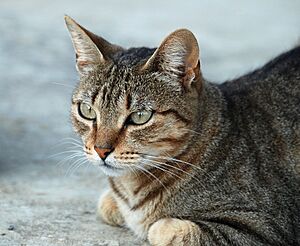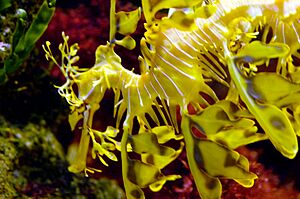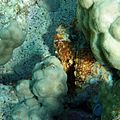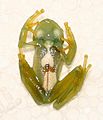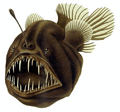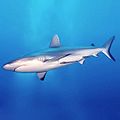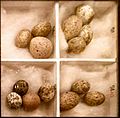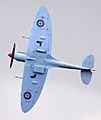Camouflage facts for kids
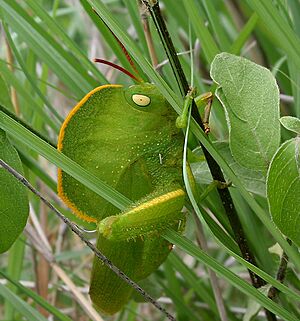
Camouflage is a way to hide by blending in with your surroundings. It makes an animal or object hard to see. If an animal's natural colors and patterns make it look like its environment, that's camouflage. Think of a tiger's stripes in tall grass, or a soldier's uniform in a forest.
Camouflage is a type of trick or deception. The word "camouflage" comes from the French word camoufler, which means "to disguise".
Contents
How Animals Hide in Nature
In nature, most animals blend into their environment. They become very hard to spot. This helps them survive and have babies. Animals that are dangerous to eat, like wasps, do the opposite. They use bright warning colors to tell others to stay away.
Animals that are prey (hunted) use camouflage to hide from predators (hunters). Predators also use camouflage to sneak up on their prey without being seen. Blending in with their surroundings is a common way animals do this. Another way is for an animal to look like something harmless, like a leaf or a stick.
Some camouflaged animals also copy movements in nature. For example, they might sway like a leaf blowing in the wind. Other animals attach natural things like twigs or sponges to their bodies to hide. Some animals can even change color! This can happen with the seasons, like Arctic animals such as the arctic fox or arctic hare. Or it can happen very quickly, like with a chameleon or cuttlefish.
Some herd animals, like zebras, have patterns that make it hard for a predator to pick out one animal when they are all running together.
Mimicry is a special kind of camouflage. It's when an animal or plant looks like another one. Usually, the animal it copies is unpleasant to eat or dangerous.
Countershading: Dark on Top, Light Below
Most animals are darker on their backs and lighter on their bellies. This is called countershading. Light usually comes from above, like the sun. The darker back absorbs light, and the lighter belly reflects it. This makes the animal look flatter and less noticeable.
We know this works because of animals that live upside down. A good example is the Nile catfish, which swims with its belly facing up. In this case, its belly is dark, and its back is light. This helps it blend in while swimming upside down.
Hiding in Water: See-Through and Shiny Animals
Animals that are transparent (see-through) or partly transparent are common in the pelagic layer of the sea. This is the part of the ocean where sunlight can reach. Being transparent or shiny works better underwater than in the air. This is because less light goes deeper into the water. Also, less light reflects off things underwater compared to in the air.
Related Topics
- Military camouflage
- Mimicry
- Warning colouration: This is the opposite of camouflage, where animals want to be seen.
Gallery
-
A mantis from Madagascar looks just like a dead leaf.
-
Two flatfish blending in with the seafloor!
-
A leaf insect at home on a plant.
-
A zoo tiger looks striking, but in its natural home, it blends with the long grass.
-
Tawny Frogmouths blend in with the color and texture of tree bark. Found in Sydney, New South Wales, Australia.
-
Draco indochinensis uses several ways to hide: broken-up colors, lying flat, and hiding its shadow.
Images for kids
-
The peacock flounder can change its pattern and colors to match its environment.
-
Octopuses like this Octopus cyanea can change color (and shape) for camouflage.
-
Abbott Thayer's 1907 painting Peacock in the Woods showed a peacock as if it were camouflaged.
-
The leafy sea dragon sways like seaweeds to make its camouflage even better.
-
How counter-illumination works in the firefly squid.
-
Many animals of the open sea, like this Aurelia labiata jellyfish, are mostly transparent.
-
Glass frogs like Hyalinobatrachium uranoscopum use partial transparency to hide in the dim light of the rainforest.
-
The adult herring, Clupea harengus, is a typical shiny fish of medium depths, hidden by reflection.
-
Blackdevil anglerfish is one of several deep-sea fish hidden against very dark water with black skin.
-
The zebra's bold pattern might make it hard for observers to track them when they move.
-
Roman ships, shown on a 3rd-century AD sarcophagus.
-
Green-jacketed rifleman firing Baker rifle 1803.
-
Iron observation post hidden as a tree by Cubist painter André Mare, 1916.
-
Egyptian nightjar nests in open sand with only its camouflaged feathers to protect it.
-
Papuan frogmouth looks like a broken branch.
-
Bright green katydid has the color of fresh plants.
-
Jumping spider: an invertebrate predator hidden by broken-up patterns.
-
The flat-tail horned lizard's body is flat and has fringes to make its shadow smaller.
-
Sniper in a Ghillie suit with plant materials.
-
Male Australian Emperor dragonflies use motion camouflage to approach rivals.
-
Norwegian volunteer soldiers in Winter War, 1940, with white camouflage overalls over their uniforms.
-
Veiled chameleon, Chamaeleo calyptratus, changes color mainly based on its mood and for sending signals.
-
Countershaded Dorcas gazelle, Gazella dorcas.
-
Countershaded grey reef shark, Carcharhinus amblyrhynchos.
-
Countershaded Focke-Wulf Fw 190D-9.
-
Peppered moth caterpillars copy twigs.
-
This grasshopper hides from predators by looking like a dry leaf.
-
Armed WW1 Q-ship tricked enemy submarines by looking like a merchant ship.
-
Cuckoo adult copies a sparrowhawk, giving the female time to lay eggs in other birds' nests.
-
Cuckoo eggs copying smaller eggs, in this case from a reed warbler.
-
A Spitfire's underside 'azure' paint scheme, meant to hide it against the sky.
-
A Luftwaffe aircraft hangar built to look like a street of village houses, Belgium, 1944.
-
Red Army soldiers in the Battle of Stalingrad in snow camouflage overalls, January 1943.
-
British Disruptive Pattern Material, given to special forces in 1963 and everyone by 1968.
-
US "Chocolate Chip" Six-Color Desert Pattern developed in 1962, widely used in the Gulf War.
-
André Mare's Cubist sketch, around 1917, of a 280 calibre gun shows how art and war mixed. Artists like Mare used their skills as wartime camoufleurs (camouflage designers).
-
Camouflage clothing at an anti-war protest, 1971.
See also
 In Spanish: Camuflaje para niños
In Spanish: Camuflaje para niños


